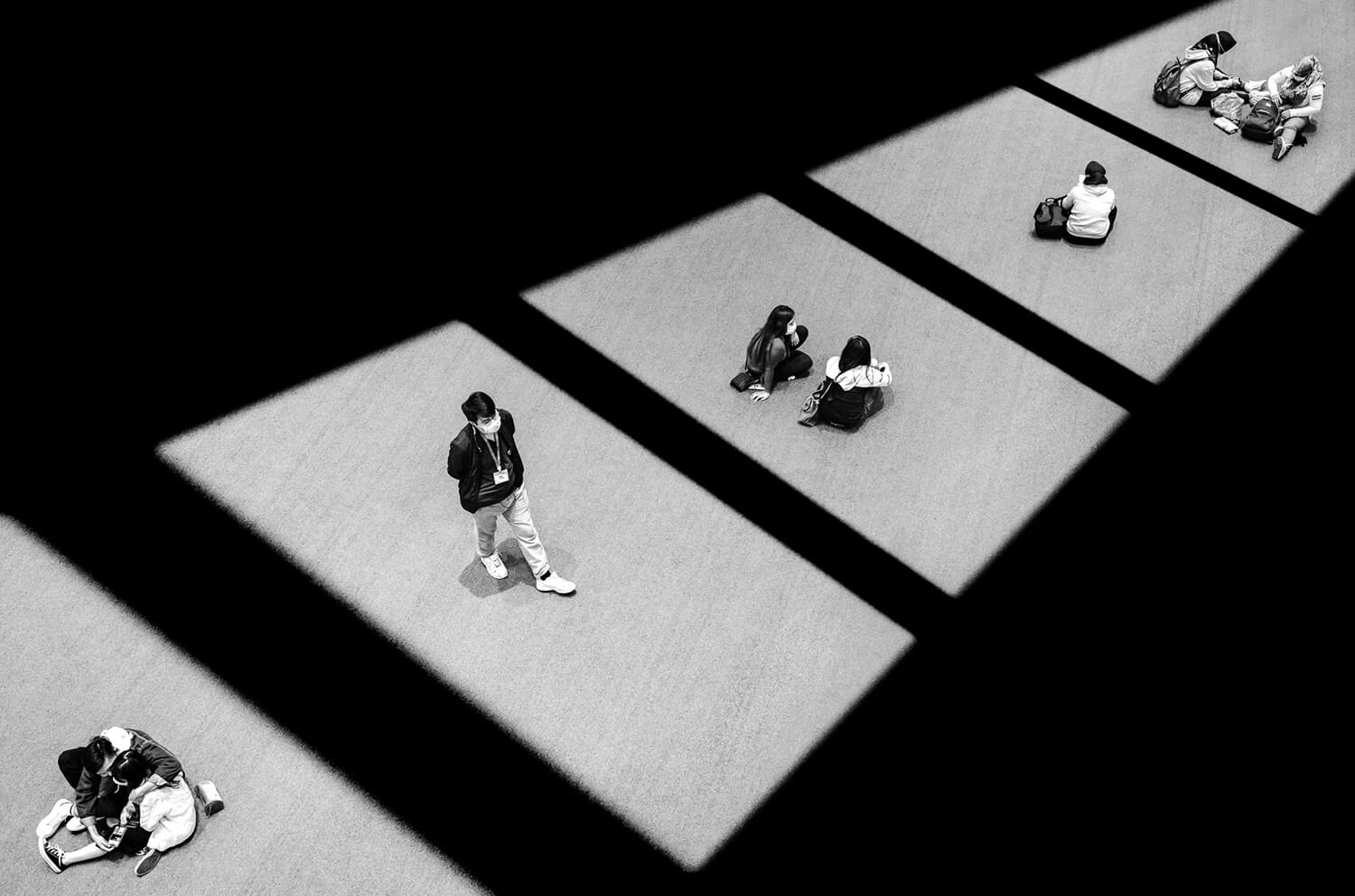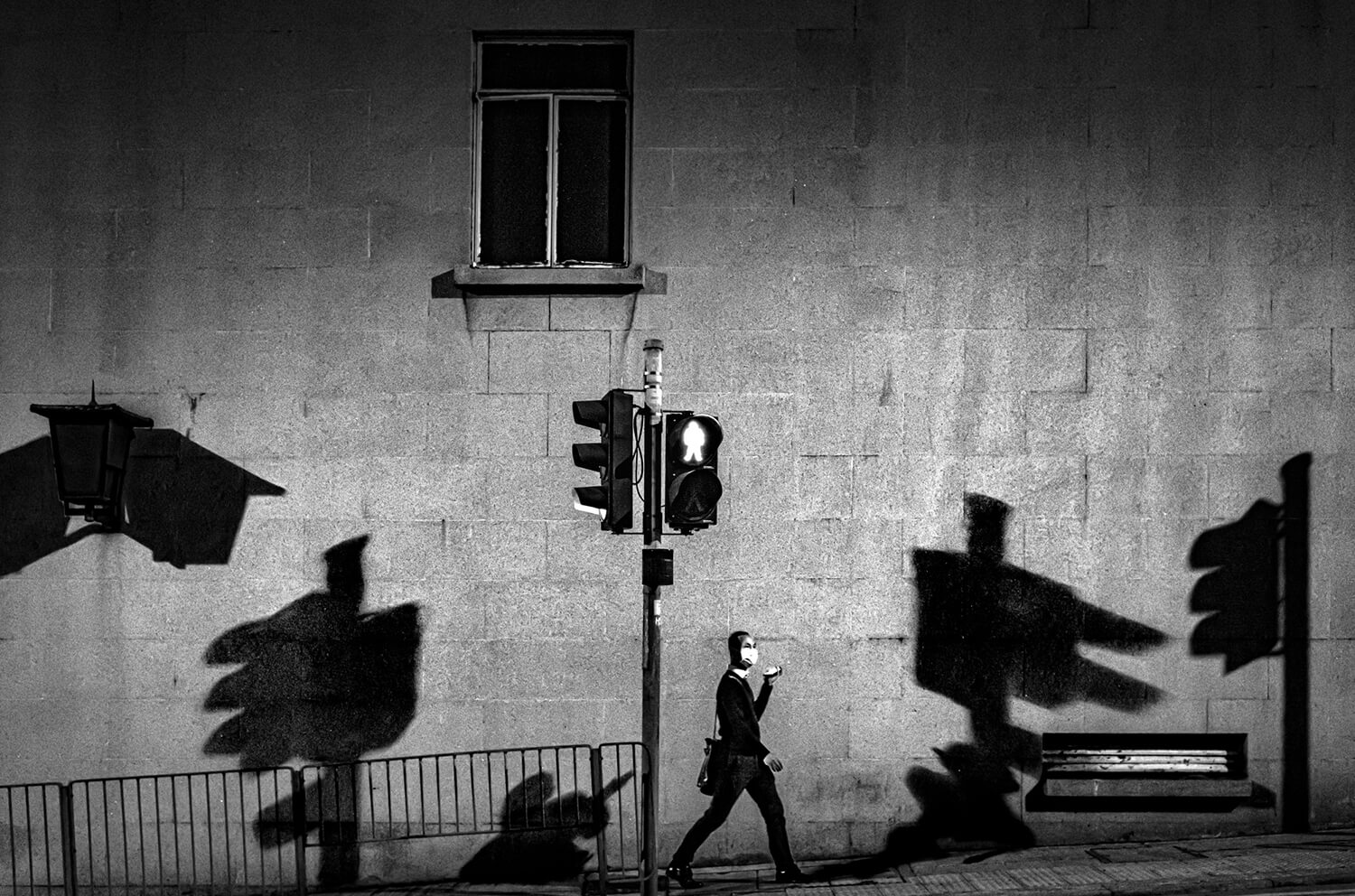INTERVIEW
A Geometric Labyrinth
WITH JASON AU
An interview with Jason Au
“It seems like we, as urban dwellers, are forced to succumb to the urban landscape, though these artificial urban landscapes are also a product of our creation. Perhaps this is the melancholic romance of modern city life.”
Jason Au won 1st Prize in our Black & White competition with an image judge Marcin Ryczek described as “perfectly captured”, praising its almost mathematical composition. Taken from a long-term project Jason has been undertaking in his home city of Hong Kong, we were keen to know more about the shot, where his love for street photography came from, and his approach to shooting on the streets – a “fisherman approach” as he tells us here…
Congratulations on winning our Black & White competition. What did you make of Marcin’s comments on the image?
Thank you! I feel honored that my work was recognized by Life Framer and Marcin Ryczek! I’ve seen Marcin’s works in photo books, and I looked up to his work very much. I think Marcin’s comments have pinpointed how I see things and compose images. Minimalism, graphical and geometric elements are the basis of my composition. I’m conscious of the balanced and structured placement of subjects across the frame, as I prefer visually pleasing images. And I believe that with good composition, the context or narrative of that image will become apparent. Marcin’s comments have succinctly reconfirmed my photographic intuition.
Tell us a little more about the image itself, and the story and circumstances behind it.
This image was taken in December 2020 amidst the rampant covid pandemic situation in Hong Kong. Depicted in this image are residents gathered in a shopping mall atrium on a Sunday; they’re sitting alone or in pairs while maintaining social distance from other groups of people. During this time, the Hong Kong government enforced a law prohibiting group gatherings of more than four persons in public places. Every group of people must maintain a minimum of 1.5-meter social distance from another group of people. Therefore, captured in the image are people sitting under the atrium while maintaining a proper social distance from another group of people. The man with the lanyard around his neck is a compliance officer enforcing the 1.5-meter-minimum social distancing rule.
We understand it’s from a long-term series about your home city, Hong Kong Lines & Patterns, and the “modern condition of how we succumb to the glory of the urban landscape”. Tell us a little more about that, and the role street photography plays in your life in the city.
“Hong Kong Lines & Patterns” is a photo series with the photographic approach of isolating urban characters in the context of their surrounding geometric environment. This series visually explores the relationship between the diminutive, lonesome human forms and the hulking urban density. Images are all captured from the mundane every day. However, one may find there’s a sense of confinement in these images. They portray a world where the urban structure crashes the people, enclosing them into small boxes with no way out, while these people look trapped and lost inside an artificial geometric labyrinth without realizing it. It seems like we, as urban dwellers, are forced to succumb to the urban landscape, though these artificial urban landscapes are also a product of our creation. Perhaps this is the melancholic romance of modern city life.
Speaking of street photography, to me, it’s in search of extraordinary moments in given environments in our daily lives. It’s true that beautiful fleeting moments are happening everywhere in our day-to-day. However, it’s the role of the street photographer to meticulously culled these interesting moments and transform them into something that looks extraordinary. When on the streets, I take great pleasure in appreciating little moments of life, seizing scenes that will disappear over time.

SOCIAL DISTANCING – JASON’S WINNING BLACK & WHITE IMAGE

TUNNEL VISION

MIDFIELDER
What keeps you heading back out into the Hong Kong streets? Any particular favorite spots?
There are always countless interesting subjects to photograph around the streets of Hong Kong. The streets are packed with scenes from different walks of life and the coexistence of modern and old buildings. More people and buildings mean lots of chances of getting an exciting shot. The street life and architecture of Hong Kong never stop to fascinate me, and I’m sure my hometown will always be my subject of interest.
My favorite spots for doing street photography in Hong Kong are located in the city center on Hong Kong Island, namely Sai Ying Pun, Sheung Wan, Central and many other parts of the island. These places used to be the historic urban settlements of Hong Kong; therefore, the streetscape around these neighborhoods has grown organically over the past century, making them full of points of interest and energy. I’ve walked around these neighborhoods repeatedly, but I would see something new every time.
Talk us through your approach to shooting out on the streets. Do you have certain rituals or creative prompts to spark inspiration? Are there any particular moments you search for, or cliches you try to avoid?
I tend to work with a street photography approach known as the “fisherman approach”. This approach means finding a strategic location with good composition and interesting elements as the backdrop, anticipating a good subject arriving at the right spot within the frame and releasing the shutter. It requires observation, pre-visualization, framing and finally, capture. The other opposite street photography approach is known as the “hunter approach”, which means the photographer is constantly on the move and looking for things to capture. However, I seldom use the “hunter approach”. I think it’s hard to control the elements within my composition. Above all, the composition is crucial as it affects the delivery of the narrative and context within the images.
Speaking of what I’m searching for while on the streets, I’m constantly looking for subjects and environments with good forms and geometry. I’m fond of a visual effect called ‘chiaroscuro’, which means strong contrasts between lights and shadows. I think good light can elevate your images to another level. There are cliches I try to avoid in my street photography. I always try to prevent my shot as simply a collage of random subjects, lines and shapes. This kind of image usually lacks coherence or narrative quality.
How did you first get into photography? Was there an “aha!” moment where it clicked and you realized it’d be an ongoing passion for you?
I first got into street photography in late 2017 after I came across the works of Fan Ho (1931-2016), a Hong Kong master street photographer dubbed the ‘Henri Cartier-Bresson of the East”, who has captured evocative black and white images of Hong Kong’s streets during the 1950s-60s. Until now, I’m still profoundly inspired by his poetic images, which are full of geometry, lights and shadows.
The “aha!” moment came around 2020 when I progressed from doing snap-shot kind of street photography to acquiring a more refined photography style. As I looked at and learned about the works of the photographers I love, I became more and more passionate and serious about the craft. I continued honing my style and skills, getting new shots, and suddenly, “Hong Kong Lines & Patterns” emerged. For the past two years, I’ve been submitting my work to photo competitions. To my surprise, the feedback has been quite positive. My images were awarded several times and featured in publications and newspapers. I feel so rewarded, so I’m even more driven to expand my body of work. Street photography will definitely be an ongoing passion for me.

BUILDING FACADES

DIFFERENT PATHS

TRIGONOMETRY

LOOKING DOWN
You shoot exclusively in black & white. Is that a conscious decision, or something you fell into? And what keeps you shooting in black & white rather than color?
Black & white has been my preferred medium of expression since the beginning. Perhaps I’m influenced by Fan Ho’s works, but black & white captivates me with its mesmerizing quality that can transform the mundane into something extraordinary. It strips away realism to a certain extent. Therefore, the subjects depicted can be realistic, abstract, and surreal at the same time. Black & white renders images with a fine art aesthetic.
When looking at a black & white image, you are not distracted by the colour of the clothes people are wearing or colourful street signs and billboards in the background; instead, you’re gazing straight into the forms, gestures, and souls of your photographic subjects. That’s why I think black & white is appealing.
Perhaps you could pick a favorite shot and tell us a little bit about it?
“Social Distancing” has got to be my favorite shot. My photographic intention and style are apparent in this image, and I also love the geometric forms and candid moments of people captured in the frame. While I consider “Social Distancing” to be a work of street photography, I see the documentary value in it at the same time, as it captures an almost surreal moment portraying the three-year-long pandemic situation in my hometown.
What’s keeping you busy right now?
Aside from doing street photography right now, I’m currently working on some architectural photography projects based in Hong Kong. I’ve been exploring new photography genres for some time, and I’m eager to see what I can come up with by applying my street photography vision to other photography genres. I’m also experimenting with street photography in color, and I’d be very interested in trying out studio photography. It’s an entirely different world. The photographer has to set up everything else out of nothing. It’s the complete opposite of street photography. Street photography is essentially about controlling the chaos.
And finally, if there was one piece of advice you could share with your younger self, or perhaps with someone starting their journey in street photography what would it be?
Look for and work hard to develop your photography style. Make it something recognizable by people so that they’ll know this is your work. Delve into the works of the street photographers you admire. You’ll also learn a lot by looking into photo books. These sources of inspiration will gradually guide you to realize your vision and forge your photography style.
Also, be self-critical. Evaluate the shots you took from time to time. Ask yourself why you prefer this image over the others. Look for mistakes in your pictures and avoid them next time. Another piece of advice would be to spend some time sequencing your images and arranging them into different series, as it will give your works a different light. First and foremost, put in the hours shooting a lot on the streets, keep experimenting and failing, and you’ll get there eventually.

WORKING PLATFORM

SHADOW PLAY

OBSESSION
